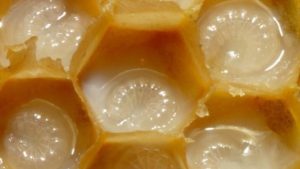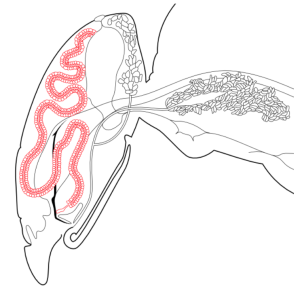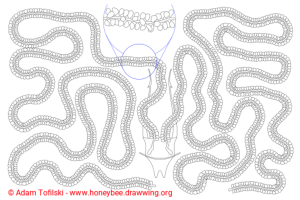of the Honey Bee
By: Ed Erwin
The hypopharyngeal glands could easily be considered “The Royal Glands of the Honey Bee,” since they secrete a substance known as royal jelly. In 1792, Francois Huber of Switzerland coined the term “gelee ryale” – royal jelly. Royal jelly is distinguished by its high levels of enriched nutrients. The jelly is a viscous substance secreted by worker nurse bees and is the essential food for the queen bee, honey bee worker and drone larvae. This gland is responsible for delivering the rich royal jelly proteins that stimulate their growth and development and plays an essential role in the diet and caste differentiation of honey bees.
 Located in the head of young nurse worker bees, the hypopharyngeal glands consist of a pair of long food glands coiled in the sides of their head. They are found bilaterally in front of the brain, between their compound eyes that are located below the pharynx, which is an opening near the respiratory and digestive tracts. The gland is composed of two cell units connected to the secretory duct in the bee. Each unit is composed of thousands of secretory units and duct cells designed to produce and discharge the jelly.
Located in the head of young nurse worker bees, the hypopharyngeal glands consist of a pair of long food glands coiled in the sides of their head. They are found bilaterally in front of the brain, between their compound eyes that are located below the pharynx, which is an opening near the respiratory and digestive tracts. The gland is composed of two cell units connected to the secretory duct in the bee. Each unit is composed of thousands of secretory units and duct cells designed to produce and discharge the jelly.
These glands are also sometimes known as the “brood food glands.”
The age of the worker bee has an effect on the activity and physiology of the hypopharyngeal glands. The structure of the glands begins developing about a week before they emerge as adults and continues to change until they die. The glands are well-developed in nurse bees and they gradually decrease in size in the foraging stage of life.
For bees, pollen is the primary source of the ten amino acids and lipids they need to build protein, while nectar is considered the bees’ source of carbohydrates. Pollen is stored in the hive and consumed throughout the life of the bee. Most of the pollen is eaten by nurse bees. The nurse bees use the nutrients absorbed from the pollen and bee bread to secrete royal jelly from their hypopharyngeal glands. Bee bread is a mixture of honey, nectar, enzymes, bacteria and yeast that begin to grow on the pollen. This mixture allows the pollen to germinate into a sticky porridge-like ingredient – being an important component of the food for larva.

Hypopharyngeal glands, side view.
From www.honeybee.drawwing.org
When the honey bee emerges from its pupal stage it is considered an adult. After about three days the jelly is mixed with bee bread and fed to the workers and drones until they spin their cocoons. Conversely, queens receive a steady diet of royal jelly throughout their larval development. It causes the queen bee to grow twice as large as a worker bee and gives her a longer lifespan than the other bees.
The worker honey bees also produce invertase in the hypopharyngeal glands. Invertase is a salivary enzyme that hydrolyzes sucrose and other enzymes, which oxidizes into glucose and acid. Research has shown that invertase is also a honey preservative.
Consumption of pollen and carbohydrates is dependent on the bee’s age. During the first three to five days of an adult worker’s life, pollen is consumed and the body weight increases by 25 to 50%. During this period, the bee’s body fat increases along with the development of their hypopharyngeal glands and other internal organs.
Nutritional Composition and Benefits of Pollen
On average, pollen contains about 22-23% protein which has significant nutritional value and is needed in the chemical processes essential for life. Pollen is also a source of nucleic acids, DNA and RNA, lipids, vitamins, minerals and carbohydrates.
If sufficient pollen is not available and the quality of pollen protein content necessary for development is poor, it will cause a loss of weight. Growth will also be stunted resulting in a reduced lifespan. It is important that bees eat a variety of pollens in order to receive all the necessary amino acids to produce healthy bees. Most pollen is missing a few of these amino acids, creating the need for a variety of pollens.
If the quality and quantity of natural pollen is unavailable, due to Summer droughts or freezing Winter, you should consider providing substitute pollen.

Hypopharyngeal glands.
From www.honeybee.drawwing.org
In order to ensure the bees have sufficient nutrients needed to raise brood you should begin feeding substitute pollen two to three months prior to the first freeze. During this period “Winter bees” are being raised that will live longer than Summer bees. These bees need a complete diet for their immune systems and fat stores to survive the Winter. Continue feeding a month after the first freeze and then again two weeks before the blooming of pollen bearing plants in Spring.
A good pollen substitute will contain up to 60% protein along with other nutritious ingredients found in natural pollen, which is twice the concentration of normal pollen. Providing your bees the supplemental pollen can allow the hive to build up worker bees prior to the honey flow in the Spring.
Harvesting Royal Jelly
Royal jelly is principally considered a commercial product sold worldwide and is highly perishable, and one of the most difficult of all foods to harvest. This accounts for its scarcity and high prices.
Extraction requires: cutting open the honey comb cells, extracting the jelly and then proper storage. A good explanation of this process can be found at Beekeepinglove.com under the blog section titled: How to Harvest Royal Jelly From Bees? – Everything You Should Know.
Benefits of Royal Jelly to Humans
Although the use of royal jelly used by humans is controversial, it is believed that it boosts the immune system and memory. It’s also thought to improve the cardiovascular system, promote longevity and reinvigorates the body. A major ingredient of royal jelly is pantothenic acid which is useful in treating some bone and joint disorders. When this acid is injected, symptoms of rheumatoid arthritis tend to subside. When royal jelly is combined with pantothenic acid better results have been reported.
As a human diet item royal jelly use has increased significantly by people who want natural, healthy foods, and nutraceuticals which are foods containing health-giving additives and having medicinal benefits. Royal jelly is nutritious and enriched with nutrients. It has also been used as an alternative medicine in treating menopausal symptoms. Royal jelly is also a good source of bifidobacteria, which are the beneficial bacteria that support digestive health. Royal jelly can be taken by capsules or directly. It tastes a little like honey, but with sour, bitter or acidic complex flavors that taste like medicine.








